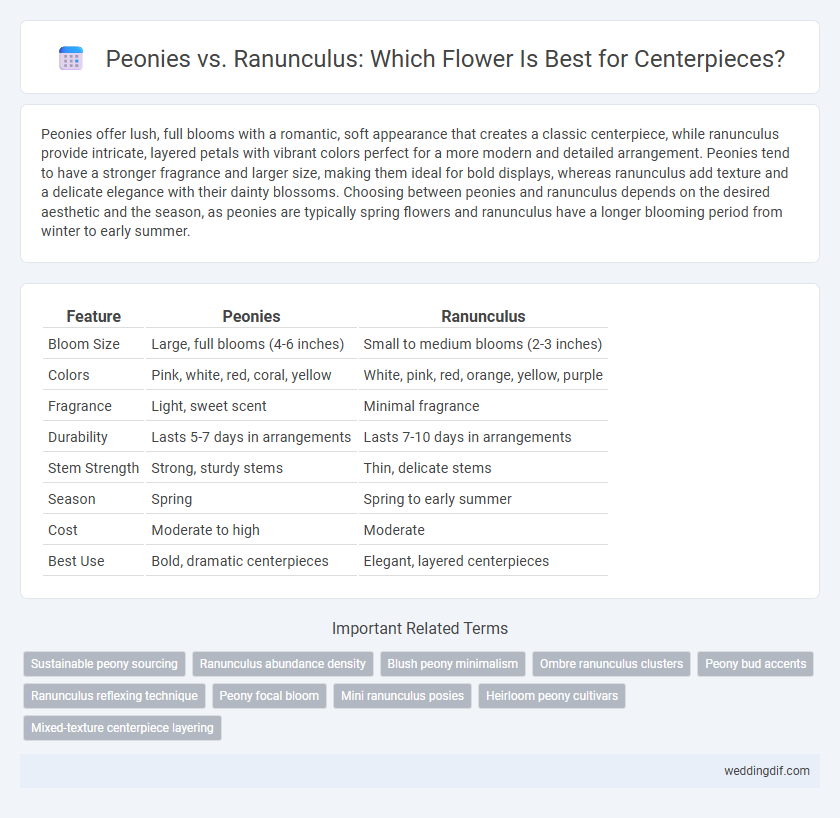Peonies offer lush, full blooms with a romantic, soft appearance that creates a classic centerpiece, while ranunculus provide intricate, layered petals with vibrant colors perfect for a more modern and detailed arrangement. Peonies tend to have a stronger fragrance and larger size, making them ideal for bold displays, whereas ranunculus add texture and a delicate elegance with their dainty blossoms. Choosing between peonies and ranunculus depends on the desired aesthetic and the season, as peonies are typically spring flowers and ranunculus have a longer blooming period from winter to early summer.
Table of Comparison
| Feature | Peonies | Ranunculus |
|---|---|---|
| Bloom Size | Large, full blooms (4-6 inches) | Small to medium blooms (2-3 inches) |
| Colors | Pink, white, red, coral, yellow | White, pink, red, orange, yellow, purple |
| Fragrance | Light, sweet scent | Minimal fragrance |
| Durability | Lasts 5-7 days in arrangements | Lasts 7-10 days in arrangements |
| Stem Strength | Strong, sturdy stems | Thin, delicate stems |
| Season | Spring | Spring to early summer |
| Cost | Moderate to high | Moderate |
| Best Use | Bold, dramatic centerpieces | Elegant, layered centerpieces |
Peonies vs Ranunculus: A Centerpiece Showdown
Peonies boast lush, voluminous blooms with a soft, romantic appeal, making them a popular choice for centerpiece arrangements that command attention. In contrast, Ranunculus offer tightly layered petals and a more delicate, intricate texture, ideal for adding refined elegance and color variety to table settings. When choosing between Peonies and Ranunculus for centerpieces, factors such as bloom size, longevity, and seasonal availability significantly influence the overall aesthetic and mood of the arrangement.
Visual Appeal: Comparing Peony and Ranunculus Blooms
Peony blooms showcase large, lush petals with a soft, romantic texture, making them ideal for creating dramatic and voluminous centerpieces. Ranunculus flowers feature tightly layered, delicate petals with vibrant color variations, offering a refined and intricate visual appeal. Both flowers provide unique aesthetics; peonies emphasize fullness and softness, while ranunculus delivers precision and vivid detail in floral arrangements.
Color Variety: Options with Peonies and Ranunculus
Peonies offer a rich palette of colors ranging from soft pastels like blush pink and creamy white to deep reds and vibrant coral, making them versatile for elegant centerpieces. Ranunculus blooms provide bright, saturated hues including vivid yellows, bold oranges, and rich purples, ideal for adding a lively pop of color. Both flowers deliver diverse color options, but peonies tend to highlight softer romantic tones, while ranunculus excels in bold, eye-catching vibrancy.
Seasonal Availability for Weddings
Peonies are typically in season from late spring to early summer, making them ideal for May and June weddings, while ranunculus bloom from late winter through early spring, perfectly suited for weddings from February to April. Peonies offer lush, full blooms that create a romantic, classic centerpiece, whereas ranunculus provide vibrant colors and intricate petal structures for a more delicate look. Choosing between peonies and ranunculus for wedding centerpieces often depends on the desired floral style and the specific wedding date within their overlapping but distinct seasonal availability.
Scent Factor: Fragrance Differences
Peonies emit a sweet, fresh fragrance that enhances any centerpiece with a soft, romantic aroma, creating an inviting atmosphere. Ranunculus flowers tend to have a more subtle scent, often described as light and slightly citrusy, making them ideal for those preferring less intense fragrances. Choosing between these flowers for centerpieces depends on the desired scent intensity, with peonies offering a stronger, more noticeable fragrance compared to the delicate aroma of ranunculus.
Stem Strength and Vase Life
Peonies offer robust stem strength, making them ideal for sturdy and tall centerpieces that maintain form throughout events. Their vase life ranges from 5 to 7 days, requiring cool water and regular maintenance to prolong freshness. In contrast, ranunculus stems are more delicate and flexible, often needing floral supports, but they boast a slightly longer vase life of up to 10 days under optimal conditions.
Styling Flexibility: Peonies vs Ranunculus
Peonies offer a lush, voluminous texture that creates a soft, romantic centerpiece, while ranunculus provide delicate, tightly layered petals that bring an elegant, structured appearance. Peonies are ideal for classic, garden-inspired arrangements with a natural, full-bodied look; ranunculus excel in modern or minimalist styles due to their refined shape and variety of vivid colors. Both flowers pair well with greenery and complementary blooms, but ranunculus allow more versatility in compact or tall vase designs, enhancing styling options for diverse event themes.
Budget Considerations for Centerpieces
Peonies typically cost more than ranunculus due to their seasonal availability and larger blooms, making ranunculus a more budget-friendly option for centerpieces. Ranunculus offers vibrant colors and a similar lush aesthetic at a lower price point, ideal for event planners working with tighter budgets. Selecting ranunculus allows for fuller arrangements without compromising on visual impact, maximizing value in floral centerpieces.
Pairing with Other Wedding Flowers
Peonies pair beautifully with roses, hydrangeas, and gardenias, creating lush, romantic centerpieces with soft, full blooms that enhance wedding elegance. Ranunculus complements anemones, tulips, and eucalyptus, offering intricate textures and vibrant colors that bring a whimsical, delicate feel to floral arrangements. Selecting either flower depends on the desired ambiance, with peonies delivering classic opulence and ranunculus adding refined charm to mixed bouquets.
Final Tips: Choosing Between Peonies and Ranunculus
Peonies offer large, lush blooms with a soft fragrance, making them ideal for romantic and elegant centerpieces, while ranunculus provide delicate, layered petals and a longer vase life suitable for intricate, modern arrangements. Consider the seasonality; peonies are typically available in late spring to early summer, whereas ranunculus bloom from winter through early spring. Balance the overall theme and color scheme of your event when selecting between these two, ensuring the flowers complement the atmosphere and desired aesthetic.
Peonies vs Ranunculus for centerpieces Infographic

 weddingdif.com
weddingdif.com